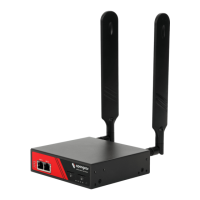Chapter 2: System Configuration
16
Telnet can be used to give an administrator access to the system command line shell.
This service may be useful for local administrator and the user access to selected
serial consoles. We recommended that you disable this service if the console server is
remotely administered.
The Enable Telnet command shell checkbox will enable or disable the Telnet service.
An alternate Telnet port to listen on can be specified in Alternate Telnet Port (default
port is 23).
SSH This service provides secure SSH access to the console server and attached devices –
and by default the SSH service is running and enabled on all interfaces. It is
recommended you choose SSH as the protocol where an administrator connects to
the console server over the Internet or any other public network. This will provide
authenticated communications between the SSH client program on the remote
computer and the SSH sever in the console server. For more information on SSH
configuration See Chapter 8 - Authentication.
The Enable SSH command shell checkbox will enable or disable this service. An
alternate SSH port to listen on can be specified in SSH command shell port (default
port is 22).
3. Enable and configure other services:
TFTP/FTP If a USB flash card or internal flash is detected on an console server, checking Enable
TFTP (FTP) service enables this service and set up default tftp and ftp server on the
USB flash. These servers are used to store config files, maintain access and
transaction logs etc. Files transferred using tftp and ftp will be stored under
/var/mnt/storage.usb/tftpboot/ (or /var/mnt/storage.nvlog/tftpboot/ on ACM7000-
series devices). Unchecking Enable TFTP (FTP) service will disable the TFTP (FTP)
service.
DNS Relay Checking Enable DNS Server/Relay enables the DNS relay feature so clients can be
configured with the console server's IP for their DNS server setting, and the console
server will forward the DNS queries to the real DNS server.
Web Terminal Checking Enable Web Terminal allows web browser access to the system
command line shell via Manage > Terminal.
4. Specify alternate port numbers for Raw TCP, direct Telnet/SSH and unauthenticated Telnet/SSH
services. The console server uses specific ranges for the TCP/IP ports for the various access
services that users can use to access devices attached to serial ports (as covered in Chapter 3 –
Configure Serial Ports). The administrator can set alternate ranges for these services and these
secondary ports will be used in addition to the defaults.
The default TCP/IP base port address for Telnet access is 2000, and the range for Telnet is IP
Address: Port (2000 + serial port #) i.e. 2001 – 2048. If an administrator were to set 8000 as a
secondary base for Telnet, serial port #2 on the console server can be Telnet accessed at IP
Address:2002 and at IP Address:8002. The default base for SSH is 3000; for Raw TCP is 4000;
and for RFC2217 it is 5000
5. Other services can be enabled and configured from this menu by selecting Click here to
configure:
Nagios Access to the Nagios NRPE monitoring daemons
NUT Access to the NUT UPS monitoring daemon

